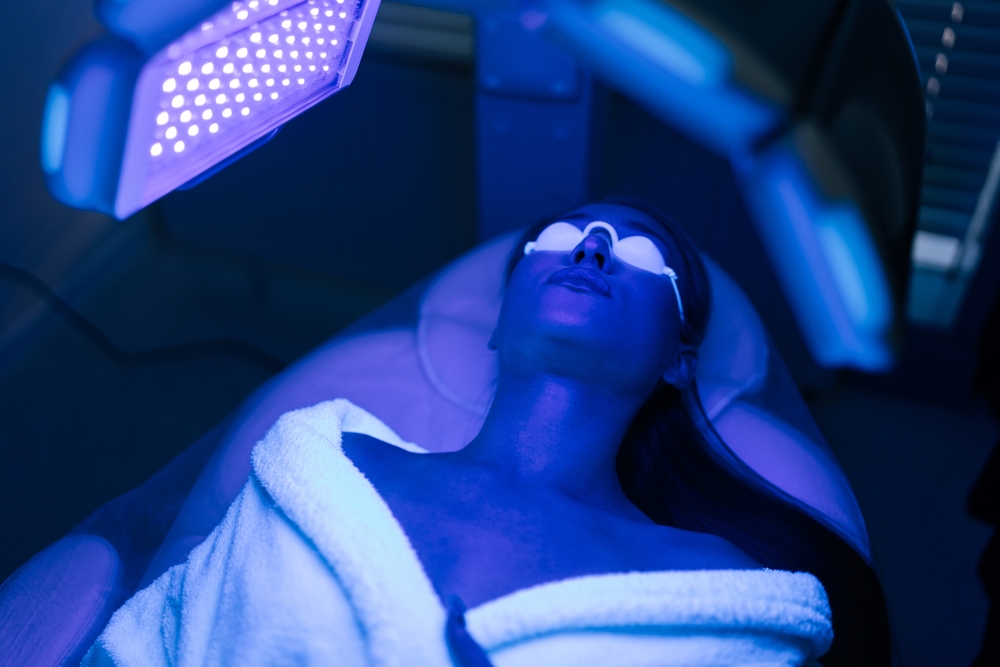There’s something deeply personal about our skin. It carries our stories, whether they are sun-soaked summers, teenage breakouts, stressful years, or healing moments. When your skin changes, it’s more than cosmetic. It can chip away at your confidence, distract you at the worst times, or keep you from doing the things you love.
Maybe you’ve spent months battling a stubborn patch on your face or a recurring spot on your scalp. Maybe you’ve just had a dermatologist mention words like “precancerous” and now you’re on the edge of uncertainty. Photodynamic therapy isn’t just about healing skin. It’s about helping you reclaim comfort, peace of mind, and the quiet confidence that comes when your reflection feels like you again.
What Is Photodynamic Therapy (PDT), Really?
Photodynamic therapy (PDT) is a medical treatment that combines a light-sensitive solution and a special light source to destroy abnormal or damaged skin cells. It’s been widely used for treating precancerous skin lesions like actinic keratosis, sun damage, and some types of superficial skin cancers. What makes it unique is that it targets only the cells that are problematic, leaving the healthy surrounding tissue intact.
But it’s not just for serious conditions. Many patients turn to PDT to improve the overall health and appearance of their skin, especially when years of sun exposure have left their mark. It’s both therapeutic and cosmetic.
PDT is particularly beneficial because it offers a highly localized effect with minimal side effects. It avoids the systemic impact of oral medications and doesn’t require the invasive nature of surgery. This makes it a preferred option for those looking for a targeted yet gentle approach to skin care. Dermatologists can tailor the strength and duration of PDT treatments based on your individual skin type and goals, ensuring a customized experience that truly fits your needs.
How It Works: A Simple Breakdown
Let’s demystify what actually happens during photodynamic therapy:
- Prep the Skin: The treatment area is gently cleaned, and a topical solution, usually a substance called aminolevulinic acid (ALA), is applied. This liquid gets absorbed by abnormal or damaged cells over the next one to three hours.
- Let It Activate: The solution needs time to soak in and become active. You’ll likely wait under minimal light while it does its thing. This is called the incubation period.
- Light Activation: Once the solution has been absorbed, your dermatologist uses a special blue or red light to activate it. This interaction causes a chemical reaction that destroys the abnormal cells without harming the surrounding skin.
- Recovery Begins: The treated area might look red or slightly sunburned for a few days, but the damaged cells will eventually flake off, leaving clearer, healthier skin behind.
During the process, many people find the experience easier than expected. While there may be mild discomfort during the light exposure, the treatment is quick and recovery typically lasts less than a week. It’s a controlled process, done in-office, and you’re supported by trained professionals every step of the way.
Why People Choose PDT
Photodynamic therapy has quietly become one of dermatology’s best-kept secrets. It’s safe, non-invasive, and it doesn’t involve surgery or deep tissue damage. For those looking to avoid more aggressive treatments, it’s an attractive option.
Here’s a look at what PDT can do for different conditions:
| Condition Treated | What PDT Does | Why It’s Effective |
| Actinic Keratosis | Targets and removes precancerous cells caused by sun damage | Destroys abnormal cells before they develop into cancer |
| Superficial Basal Cell Carcinoma | Treats certain non-melanoma skin cancers on the surface | Minimizes scarring, suitable for sensitive areas like face or scalp |
| Acne | Reduces oil production and kills acne-causing bacteria | Helps clear stubborn, cystic, or recurring acne |
| Sun-Damaged Skin | Improves texture and reduces pigmentation | Rejuvenates skin while removing damaged tissue |
| Enlarged Pores and Uneven Texture | Gently exfoliates and tightens the skin | Gives a smoother, more refined appearance |
Aside from its medical benefits, PDT is also seen as a confidence-restoring solution. For many, it extends beyond just about eliminating a skin concern. It’s about regaining a sense of control and trust in your own skin. This emotional component can be just as powerful as the physical changes PDT provides.
PDT also stands out because it bridges the gap between clinical and cosmetic results. Many patients who originally sought PDT for medical reasons are delighted to see cosmetic improvements like smoother texture, even tone, and smaller pores. This dual benefit often leads to greater satisfaction with fewer treatments.
What It Feels Like and What to Expect
Most patients are pleasantly surprised by how manageable PDT feels. During the light activation, you may experience a stinging or warm sensation, kind of like a sunburn starting to settle in. But it’s temporary. After the treatment, your skin will likely be red and maybe a bit swollen for a few days, especially in more sensitive areas.
The important part? Staying out of the sun during your recovery. Because the treatment makes your skin temporarily more sensitive to light, your dermatologist will strongly recommend staying indoors and avoiding sun exposure for at least 48 hours after the procedure.
Here’s what a general timeline looks like:
- Day 1-2: Redness, tightness, possible peeling
- Day 3-5: Skin may flake or lightly scab
- Day 6-7: New skin begins to appear, clearer and smoother
This timeline can vary based on how your skin reacts and how extensive the treatment area is. In most cases, improvements become more visible after the peeling phase. If you’ve had lingering skin concerns, even small progress can feel incredibly uplifting.
Expect to be given detailed aftercare instructions that can include moisturizing tips, what to avoid, and how to ease any discomfort. Following these steps makes a noticeable difference in your skin’s ability to heal well and quickly.
Who’s a Good Candidate for PDT?
You don’t need to have a scary diagnosis to benefit from photodynamic therapy. In fact, some of the best candidates are people who just want to proactively protect their skin or undo the damage caused by too many sunny days.
You may be a good fit if:
- You’ve been diagnosed with actinic keratosis or superficial skin cancers
- You’re prone to breakouts that haven’t responded to other treatments
- You have visible sun damage, blotchiness, or uneven skin tone
- You’re seeking a non-invasive alternative to surgery or harsh treatments
PDT is also ideal for people who want an alternative to daily medication regimens or who have concerns about systemic side effects. If you’re not sure whether it’s right for you, a dermatologist can evaluate your skin, your medical history, and your goals to create a tailored approach.
Those with extremely sensitive skin or certain underlying conditions may need a modified treatment plan. That’s why the importance of a professional consultation can’t be overstated. It helps set expectations and ensures your skin gets exactly what it needs.
Let’s Talk Results
PDT isn’t magic, but the results can feel pretty close. Patients often report not just physical improvements, but emotional ones too. When you feel like your skin is healthier and clearer, that inner confidence starts showing up in unexpected ways.
Before-and-after stories range from people finally clearing up chronic pre-cancerous patches, to teens who’ve battled acne for years seeing their clearest skin yet. And because PDT doesn’t involve long-term medications, injections, or invasive surgery, it’s often praised for how gentle yet powerful it is. A professional dermatologist in Doylestown, PA and beyond can easily determine if it’s right for you.
Over time, many people notice that their skin not only looks better but also feels stronger and less reactive. Consistent results can lead to fewer flare-ups or lesions, less anxiety around flare-prone spots, and an overall boost in skin resilience.
Patients often talk about sleeping better, skipping makeup, or finally wearing their hair up again. These are all small, yet meaningful wins that come with feeling good in your own skin.
Things to Keep in Mind
Like any medical treatment, PDT isn’t one-size-fits-all. It works best when guided by a knowledgeable dermatologist who understands your skin type, your medical history, and your goals.
A few reminders to take under consideration:
- Stay protected: Use sunscreen diligently in the weeks following treatment
- Listen to your skin: Some redness and peeling is normal, but if you’re unsure, reach out
- Don’t skip follow-ups: Your skin is a living organ, and your needs may evolve over time
You’ll also want to plan your schedule around recovery time. It’s not the best idea to book a beach vacation the day after treatment. Instead, give your skin space to heal in peace so the full benefits of the therapy can take effect.
Scheduling your appointment when you can rest, hydrate, and stay out of the sun makes a big difference in your comfort and results. Having realistic expectations about downtime ensures a smoother experience.
Real Support for Real Skin Concerns
Let’s be honest. Skin issues can feel more emotional than we often let on. They can chip away at your confidence, distract you during conversations, or make you feel like you have to explain yourself all the time. What PDT offers isn’t just treatment—it’s relief. It’s the ability to move through the world without that constant reminder on your cheek, forehead, or nose.
And the best part? It’s not about covering up. It’s about healing from the inside out.
Dermatologists who offer PDT understand that they’re not just treating a condition. They’re supporting your emotional and mental wellness, too. It’s okay to feel nervous, hopeful, or even skeptical. You deserve answers and guidance every step of the way.
Whether your concern is visible or not, PDT reminds us that skin care is deeply personal. Having a provider who listens and creates a plan just for you is a game changer.
Ready to Explore PDT for Yourself?
Whether you’ve been dealing with sun damage, stubborn acne, or a recent diagnosis of actinic keratosis, exploring photodynamic therapy in Southampton, PA and the surrounding areas might be the solution you’ve been waiting for. It’s precise, powerful, and built around the idea that good skin health doesn’t have to come with downtime or discomfort.
The team at Pennsylvania Dermatology Specialists is ready to help guide you through your options with clarity, compassion, and deep expertise. Because when it comes to your skin, you deserve answers, not guesswork.
Booking a consultation can be the first step in turning uncertainty into a personalized plan. There’s no pressure or rush. It’s just a chance to explore what’s possible, and that’s valuable.
Let’s take the next step together. Schedule your consultation today and discover if photodynamic therapy can help you get closer to the skin and the confidence you’ve been waiting for.









